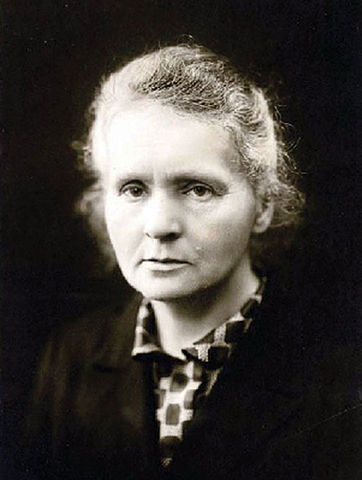There’s no way I could possibly go through a long history-of-science blog series without mentioning the great Marie Skłodowska Curie, one of the very few people in history to win not one but two Nobel Prizes for her scientific work– if nothing else, Polish pride would demand it. She made a monumental contribution to physics through her work on radioactivity (and through being nearly impossible to kill– while her work on isolating radium made her ill for many years, she outlived an amazing number of her assistants…), and there are a lot of great stories about her.
This series is partly intended as a way to share things I wasn’t able to fit in the book, though, and in reading up on her, I ran across a story I had never heard before. It turns out that along with discovering new elements, Marie Curie helped invent Kickstarter.
The Curies were never especially well funded, by the standards of other countries, and most of their ground-breaking work on isolating polonium and radium was done in an abandoned shed in a courtyard at the École Normale Supérieure in Paris (the other space they had access to was too small to process the quantity of material needed to handle to isolate the extremely rare elements they were seeking). The German chemist Wilhelm Ostwald visited them, and described it as “a cross between a stable and a potato cellar.” This was compounded by the fact that the Curies refused to patent the process for isolating radium, and thus never got any profit from what became a huge industry.
Things got somewhat better after the two Nobel Prizes (the first shared with Pierre and Henri Becquerel in 1903, the second on her own in 1911), and Curie was able to set up a Radium Institute for the study of radioactive materials. This was still not especially lavish, though, France in the wake of WWI not being in the best shape, and many of her competitors did much better.
In 1920, Curie granted a rare interview (she was naturally pretty reserved, and a possible affair with Paul Langevin had been a huge scandal ten years earlier (leading to the “don’t feed the trolls” letter from Einstein that has been shared so much recently), so she particularly distrusted the media) to an American journalist and socialite, Marie Mattingly Meloney aka Mrs. William Brown Meloney, aka “Missy.” Meloney’s profile in the women’s magazine The Delineator helped firmly establish the popular image of Curie:
The door opened and I saw a pale, timid little woman [Curie] in a black cotton dress, with the saddest face I had ever looked upon. Her kind, patient, beautiful face had the detached expression of a scholar. Suddenly I felt like an intruder. My timidity exceeded her own. I had been a trained interrogator for twenty years, but I could not ask a single question of this gentle woman in a black cotton dress. I tried to explain that American women were interested in her great work, and found myself apologising for intruding upon her precious time.
In the course of the interview, Meloney asked Curie what she would want more than anything else, and the answer was “a second gram of radium for my research,” because the Radium Institute had only one gram in total. Shocked by this poverty of resources, and sensing a good story, Meloney declared that she would see to it that Curie got her extra radium.
This was not by any means a trivial committment, as a gram of radium ran about $100,000 in 1920. But Meloney was a force to be reckoned with, and launched a subscription campaign, the Marie Curie Radium Fund, to collect donations from the women of America to buy radium for Curie, starting with the famous profile above. In a matter of months, they had raised the money, and also arranged a massive publicity tour of the US, during which Curie accepted the radium from President Warren Harding in a ceremony at the White House in October 1921. The story goes that Curie almost backed out the night before, when she discovered that the radium was to be given to her personally, and insisted that the documents be re-drawn to give it to her Institute instead.
(This story mostly gets told pretty straight, though there are versions such as this Google Books result that put a somewhat more cynical spin on it. Curie certainly wasn’t a fan of public honors and publicity, though– she declined the Legion of France when it was offered shortly before her trip to America, and did as much as she could to beg off public appearances in the US, sending her daughters in her stead to accept some of her honorary degrees.)
So, among Curie’s many important discoveries, we can add to the list “crowd-funding pioneer.” The campaign also eventually raised funds to help establish a second Radium Institute in Warsaw (Curie always worked to support her native Poland– polonium was somewhat unique in being named for a country that didn’t technically exist at that time…), and she benefitted enormously from smallish donations from lots of international sources. This story can also stand as a demonstration of the importance of telling your scientific results to others, even including foreign journalists…
————-
(Part of a series promoting Eureka: Discovering Your Inner Scientist, available from Amazon, Barnes and Noble, IndieBound, Powell’s, and anywhere else books are sold.)
(The AIP has a very nice online biography of Marie Curie that you can check out, with lots of additional resources. I also recommend Veronique Greenwood’s story about her great-aunt who discovered francium while working at the Radium Institute under Marie and later her daughter Irène Joliot-Curie, about whom more later…)

Really? It was in the film.